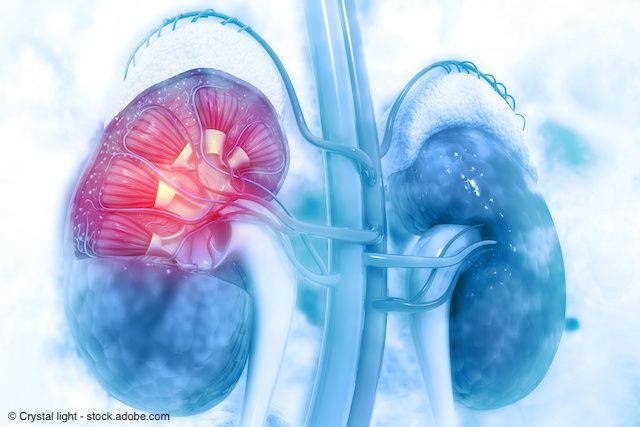Article
Tumor shrinkage, tolerable AEs seen with sintilimab plus axitinib for advanced RCC
Author(s):
“The combination of sintilimab and axitinib had a manageable safety profile and achieved a promising tumor response rate in patient with advanced FH-deficient RCC,” said Xingming Zhang.
Tumor shrinkage and tolerable adverse effects (AEs) were observed in patients with advanced fumarate hydratase (FH)–deficient renal cell carcinoma (RCC) receiving treatment with sintilimab in combination with axitinib (Inlyta).1
The combination produced an overall response rate (ORR) of 65.2% (n = 15), with 13% of patients (n = 3) achieving a complete response and 52.5% of patients (n = 12) achieving a partial response.

Primary findings from a phase 2 trial (NCT04387500) were presented at the 2023 American Urological Association Annual Meeting in Chicago, Illinois.1
The combination produced an overall response rate (ORR) of 65.2% (n = 15), with 13% of patients (n = 3) achieving a complete response and 52.5% of patients (n = 12) achieving a partial response. Additionally, 21.7% (n = 5) and 13% (n = 3) of patients had best responses of stable disease and progressive disease, respectively, and the disease control rate was 87% (n = 20). The average tumor shrinkage rate was 48%.
Non–clear cell RCC is a heterogenous disease consisting of a variety of rare subtypes, including papillary type 1 and 2, chromophobe, translocation, collecting duct, and medullary disease. Each subtype has unique histological features, clinical manifestations and responses to treatment, and some subtypes are still being reclassified.
“Although several studies explored the mechanism and potential therapeutic targets in FH-deficient RCC, efficacy of intervention against these targets is inadequate,” Xingming Zhang, of West China Hospital in Chengdu, Sichuan, said in a presentation of the data.
According to Zhang, although FH-deficient RCC has immune-hot primary tumors, the metastases have a more activated tumor immune microenvironment than the primary tumors. The study investigators hypothesized that FH-deficient RCC was characterized by high immune cell infiltration and relatively high PD-L1 expression. “Based on these findings, we proposed for the first time the immune checkpoint inhibitor combination treatment in FH-deficient RCC,” Zhang said.
This ongoing investigator-initiated trial is enrolling patients at least 18 years of age with FH-deficient RCC. Germline and/or somatic FH alterations and/or large deletions will be confirmed by gene testing. Patients are required to have an ECOG performance score of 2 or lower and an expected survival of more than 3 months.
Enrollment began on June 2, 2021, and in April 2023, 42 patients were screened and 37 patients, from 7 centers and 12 provinces in China, were enrolled in the trial. As of April 2023, 23 patients were evaluable for efficacy, and 36 patients were evaluable for safety and quality of life (QOL). This trial plans to enroll a total of 41 patients from 8 sites.
Patients received sintilimab injections at 200 mg every 3 weeks plus oral axitinib at 5 mg twice daily.
The coprimary end points of this trial were progression-free survival and ORR. Key secondary end points included overall survival and QOL. A biomarker analysis was also performed.
At a median follow-up of 10 months, by April 2023, 6 patients had disease progression and 2 patients had died from causes not related to cancer.
Regarding patient-reported outcomes, Zhang noted that the mean Functional Assessment of Cancer Therapy – kidney symptom index-19 total score was stable after treatment with the combination, with a slight increase after 6 months of treatment, and that the visual analogue scale score also remained stable.
Zhang shared a representative case report of a 28-year-old female who had previously undergone surgery for uterine fibroids and was admitted to a hospital because of a mass on her left kidney that was found by a CT scan. A PET-CT scan indicated this mass to be left kidney cancer with multiple left adrenal and lymph node metastases. This patient underwent left radial nephrectomy and resection of the adrenal and retroperitoneal tumors. Eight months after this surgery, a PET-CT scan showed primary surgical site recurrence. This patient was enrolled in the phase 2 trial and received the sintilimab/axitinib regimen. “After 3 months of treatment, the tumor had completely disappeared. We also [performed a CT scan of] the tumor after 6 months of treatment and the tumor had…completely disappeared,” Zhang explained.
All evaluable patients experienced AEs of any grade, with 25% of patients (n = 9) experiencing AEs of grade 3 or higher. The most common AEs were proteinuria (all-grade, 72.2%; grade ≥ 3, 2.8%), hypertriglyceridemia (63.9%; 8.3%), increased blood creatinine levels (63.9%; 2.8%), hypothyroidism (61.1%; 0%), increased adrenocorticotropic hormone levels (58.3%; 0%), hyperuricemia (47.2%; 0%), hypercholesterolemia (44.4%; 0%), hypercalcemia (44.4%; 0%), rash (44.4%; 2.8%), increased alanine transaminase levels (41.7%; 2.8%), urine occult blood (38.9%; 0%), diarrhea (33.3%; 0%), changes in lactic dehydrogenase levels (33.3%; 0%), changes in aspartate transferase levels (30.6%; 2.8%), increased cardiac troponin T (30.6%; 0%), palmar plantar-erythrodysesthesia (27.8%; 0%), lymphocyte count decreases (27.8%; 0%), anemia (27.8%; 5.6%), increased gamma-glutamyl transferase (25.0%; 0%), increased blood alkaline phosphatase levels (25.0%; 0%), pharyngalgia (22.2%; 0%), hyperglycemia (22.2%; 0%), fatigue (22.2%; 0%), pruritus (19.4%; 2.8%), perianal abscess (8.3%; 2.8%), anal fissure (5.6%; 2.8%), carcinomatous hydrothorax (2.8%; 2.8%), and hypertension (2.8%; 2.8%).
“The combination of sintilimab and axitinib had a manageable safety profile and achieved a promising tumor response rate in patient with advanced FH-deficient RCC,” Zhang concluded.
This is an ongoing trial.
Reference
1. Zhang X, Liu H, Zhang Y, et al. Phase II, multi-center study of sintilimab in combination with axitinib in patient with advanced fumarate hydratase-deficient renal cell carcinoma. Presented at: 2023 AUA Annual Meeting; April 28-May 1, 2023; Chic

















